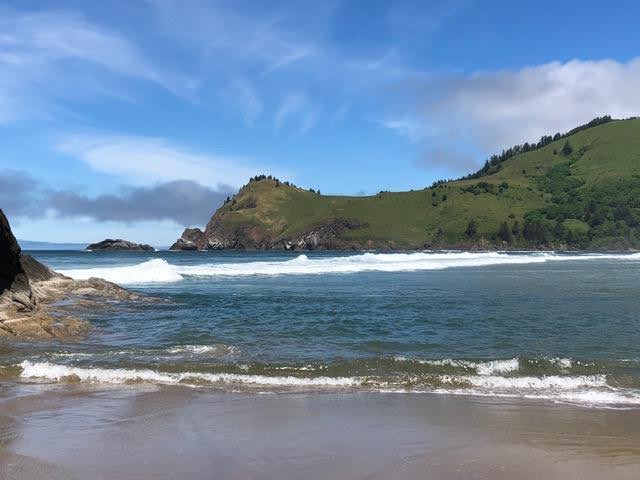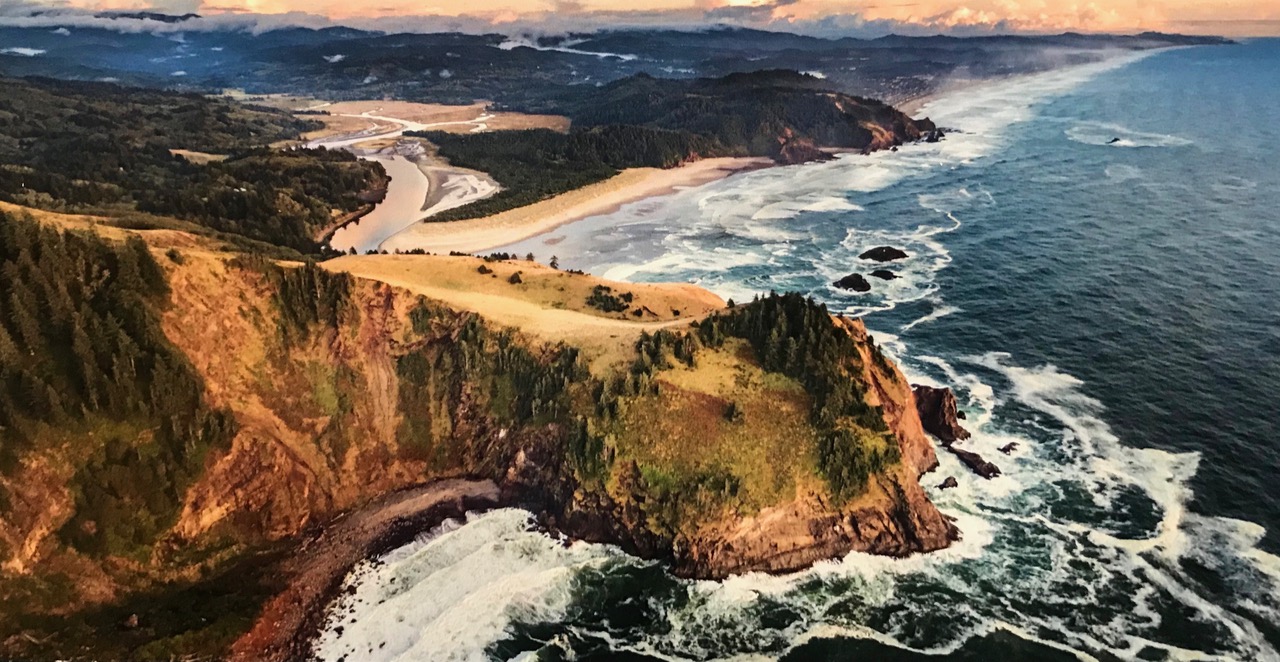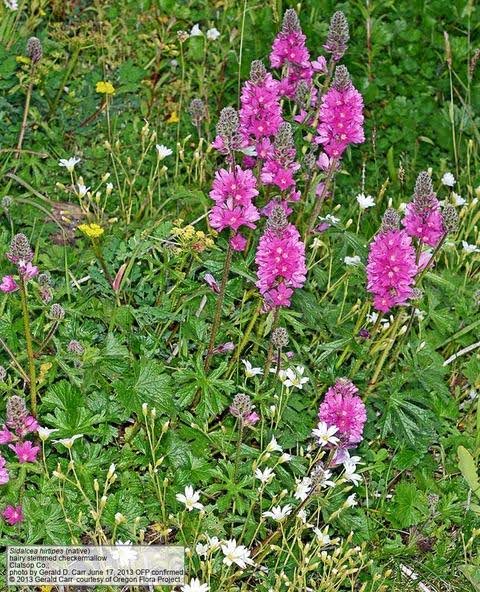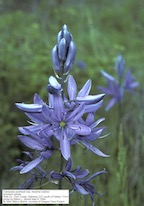NPSO 2024 Annual Meeting
May 17 - 19 Spirit Mountain Hotel, Grand Ronde, Oregon
Field Trips
Saturday May 18, 2024 9 a.m. - 4 p.m. Field Trip # 26
Cascade Head Nature Conservancy Preserve
 Photo: Kareen Sturgeon
Photo: Kareen Sturgeon
Cascade Head as seen from the beach at Camp Westwind
Difficulty: Moderate to strenuous (4.2 miles) - The lower part of the trail is steep with rocks, exposed tree roots, and uneven terrain.
Elevation: 700 feet elevation gain
Group Size Limit: 12
.jpeg) Photo: courtesy of Oregon Flora Project
Photo: courtesy of Oregon Flora Project
Hairy-stemmed checkermallow (Sidalcea hirtipes), more information: https://www.sitkacenter.org/journal/introducing-the-bristly-stemmed-checker-bloom
Trip Description: Bordered on the west by the Pacific Ocean and to the south by the Salmon River Estuary, Cascade Head is a coastal prairie offering spectacular views of the Oregon coast. The basalt headland originated as a seamount, an underwater extrusion of lava that occurred 40-12 million years ago when the ocean extended far inland. The Preserve and surrounding forest are recognized as a National Scenic Research Area and as components of the UNESCO Cascade Head Biosphere Reserve.
The headland provides critical habitat for the Oregon silverspot butterfly, which is federally listed as a threatened species. The larvae depend upon leaves of the hookedspur violet (Viola adunca ssp. adunca) as their sole food source and adult butterflies nectar on various species of Asteraceae. The headland requires periodic disturbance to maintain the grassland, and prescribed fire is used as a management tool, carrying on the tradition of Tribal burning at the site.
The trail meanders through a forest of Sitka spruce (Picea sitchensis), western hemlock (Tsuga heterophylla), Western red cedar (Thuja plicata), and red alder (Alnus rubra). It emerges onto a coastal prairie that is home to numerous wildflowers and native prairie grasses, including red fescue (Festuca rubra ssp. rubra), wild rye (Elymus glaucus), Kentucky bluegrass (Poa pratensis), California brome (Bromus carinatus), wild oatgrass (Danthonia californica), edible thistle (Cirsium edule), Canada goldenrod (Solidago canadensis), Pacific paintbrush (Castilleja littoralis), stream lupine (Lupinus rivularis), farewell-to-spring (Clarkia amoena), Oregon iris (Iris tenax), Menzies' larkspur (Delphinium menziesii), hairy-stemmed checkermallow (Sidalcea hirtipes), and coyote brush (Baccharis pilularis).
Appropriate Clothing and Footwear: Sturdy boots and hiking poles recommended.
Special Considerations: The headland can be windy and cold.
Meeting Place and Time: Trip # 26 leaves at 9 a.m. from parking lot west of Hotel. Plan to arrive 30 minutes before departure time to meet your group and arrange carpools.
Alternate Meeting:
Participants may also meet the trip at 9:30 a.m at Knight County Park Boat Landing, 2341 N. Three Rocks Road, Otis, Oregon 97368. If you choose this option, be sure to notify your trip leader in advance.
Driving Miles and Time from Spirit Mountain Hotel: 26 miles, 32 minutes to Knight County Park boat landing
Driving Directions: Trip leaders will provide detailed driving instructions.
Leaders: Sophie Linden, Dave Pickering, Aislinn Adams
Sophie Linden, works as the Willamette Basin Steward for The Nature Conservancy. In her off time, she’s an avid gardener, cake baker, and graminoid enthusiast.
Dave Pickering, organic farmer growing specialty fruits and vegetables for restaurants in Lincoln County who has volunteered for the Nature Conservancy of Oregon for 40 years. At the Cascade Head Preserve he’s been doing trail maintenance, prairie restoration and leading work parties and educational hikes.
Aislinn Adams, Botanical illustrator and educator, Aislinn Adams Design, Willamette Chapter
Plant Lists and Other Information: Chapter in book: "Burning Cascade Head." In Kimmerer, Robin Wall. Braiding Sweetgrass: indigenous wisdom, scientific knowledge and teachings of plants. Milkweed Editions, 2013.
 Photo: courtesy of Camp Westwind
Photo: courtesy of Camp Westwind
Cascade Head and the Salmon River Estuary at low tide
 Photo: Kareen Sturgeon
Photo: Kareen Sturgeon
View from Cascade Head
 Photo: courtesy of Oregon Flora Project
Photo: courtesy of Oregon Flora Project
Hairy-stemmed checker mallow (Sidalcea hirtipes) grows on the coastal prairie of Cascade Head.


